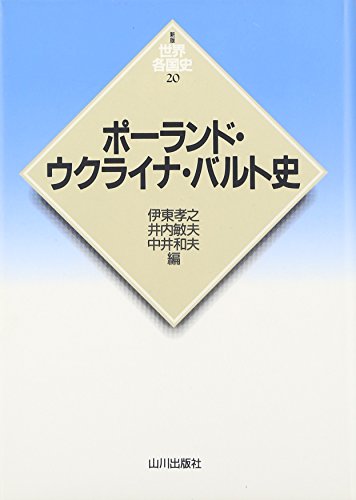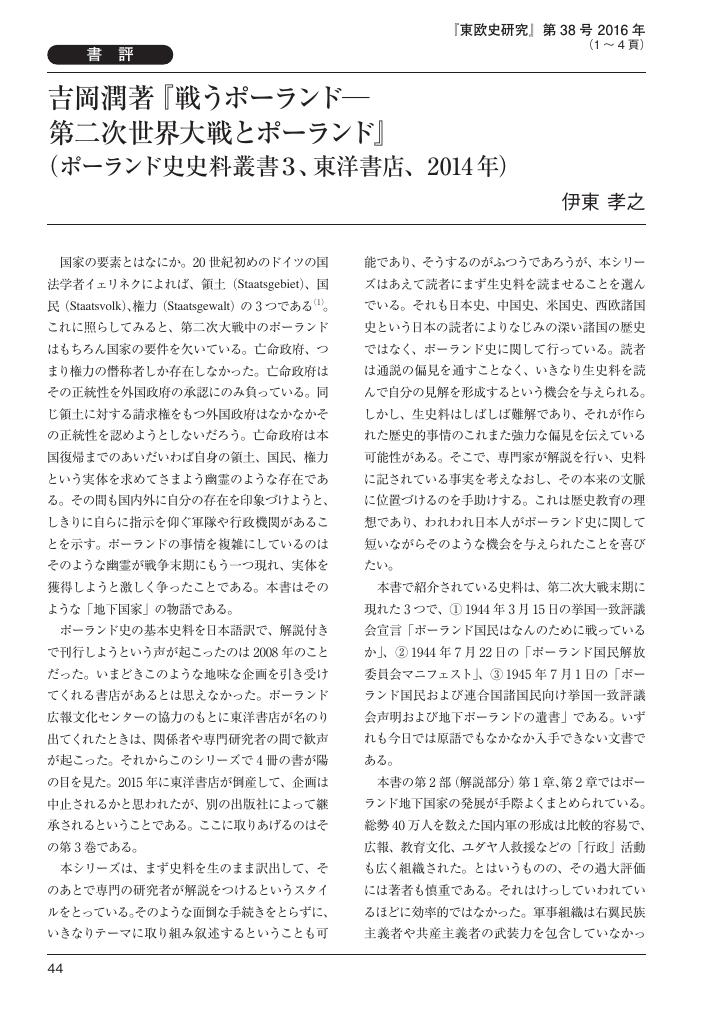13 0 0 0 「東ドイツの興亡」星乃治彦--未練学派の東独論
- 著者
- 伊東 孝之
- 出版者
- 現代史研究会
- 雑誌
- 現代史研究 (ISSN:03868869)
- 巻号頁・発行日
- no.37, pp.p54-60, 1991
6 0 0 0 ポーランド・ウクライナ・バルト史
- 著者
- 伊東孝之 井内敏夫 中井和夫編
- 出版者
- 山川出版社
- 巻号頁・発行日
- 1998
3 0 0 0 OA 世界戦争100年と東欧 ―二つの忠誠心の間で―
- 著者
- 伊東 孝之
- 出版者
- ロシア・東欧学会
- 雑誌
- ロシア・東欧研究 (ISSN:13486497)
- 巻号頁・発行日
- vol.2015, no.44, pp.5-28, 2015 (Released:2017-08-18)
When World War 1 broke out, most of the nations in Eastern Europe identified themselves with the existing Empires. Poles were mobilized into the three Empires that divided them. They ran the risk of fighting against each other. Germans in the Russian Empire fought in the Russian army against Germany. As the war progressed, however, they became aware of their ethnic identity. They were discriminated against by the authorities or the populace of the ruling nationality. Or they were manipulated by the belligerent nations against the enemy. A lot of new states came into being in Eastern Europe after the war in the name of national self-determination. Most of them, however, were not “ethnic states” in the proper sense of the word. They included many citizens of different ethnicity. On the other hand, as a result of the Russian Revolution a state based on the completely new principle came into being: the Soviet Union. It adopted ethnicity as the constituting principle of the state and formed a federation of ethnic republics. Ethnic republics were, however, just on paper. There were no institutional arrangements that would promote citizens’ allegiance to the given republic. The all-mighty Communist Party of the Soviet Union is the institution that should secure citizens’ allegiance to the federal center. So long as the ideological mobilization worked, they managed to succeed in resurrecting citizens’ civic loyalty to the state as a whole. As the international tension mounted in the course of the 1930s, the Soviet leadership started to look with mistrust on national minorities on the periphery which resulted in the mass murder in Eastern Europe. The famine in 1932–33 in Ukraine was the first case. It was no natural, but man-made disaster to which 3.3 million people fell victim. It was caused by the excessive requisition of grain that the authorities forced through for the ambitious industrialization program. Ukraine had to pay a particularly heavy toll for it. Those who tried to resist were blamed for “Ukrainian nationalism” and “actions to serve the interests of the enemy”. Most of the victims of the so-called “Great Purge” in 1937–38 were citizens of national minorities in Eastern Europe. They were suspected to be spies for Japan in the case of the “Kulak operation” and for Poland in the case of the “Polish operation”. 625,000 people were incriminated and shot to death. During World War 2 Germans and Soviets did ethnic cleansing in a huge scale in Eastern Europe. Germans considered Eastern Europe as nothing more than suppliers of raw materials, foods and labor forces, and were not interested in integrating peoples there. They starved to death about one million inhabitants of Leningrad and 3.1 million soldiers of the Red Army most of whom were conscripted from Eastern Europe. 5.4 million East European Jews fell victim to the German extermination policy after July 1941. Soviets, on the contrary, were interested in integrating peoples they captured. However, they shot to death most of the elite who cooperated with the previous regime and exiled “enemy nationalities” en masse to Central Asia or Siberia. Beneath the German-Soviet war another ethnic cleansing unfolded: Ukrainian nationalists killed about one hundred thousand Poles and Jews in Volynia. (View PDF for the rest of the abstract.)
1 0 0 0 OA 東欧の民族問題とマルクス主義の民族自決権概念 : ローザ・ルクセンブルク
- 著者
- 伊東 孝之
- 出版者
- 北海道大学スラブ研究センター
- 雑誌
- スラヴ研究 (ISSN:05626579)
- 巻号頁・発行日
- vol.18, pp.53-96, 1973
- 著者
- 伊東 孝之
- 出版者
- ロシア・東欧学会
- 雑誌
- ロシア・東欧研究 (ISSN:13486497)
- 巻号頁・発行日
- vol.2013, no.42, pp.121-124, 2013 (Released:2015-05-28)
1 0 0 0 OA 動員しきれなかった動員体制―比較政治体制論の視点から
- 著者
- 伊東 孝之
- 出版者
- ロシア・東欧学会
- 雑誌
- ロシア・東欧学会年報 (ISSN:21854645)
- 巻号頁・発行日
- vol.1997, no.26, pp.138-143, 1997 (Released:2010-05-31)
- 参考文献数
- 13
1 0 0 0 OA 吉岡潤著『戦うポーランド―第二次世界大戦とポーランド』(東洋書店、2014 年)
- 著者
- 伊東 孝之
- 出版者
- 東欧史研究会
- 雑誌
- 東欧史研究 (ISSN:03866904)
- 巻号頁・発行日
- vol.38, pp.44-47, 2016 (Released:2019-06-15)
- 著者
- 伊東 孝之
- 出版者
- 東欧史研究会
- 雑誌
- 東欧史研究 (ISSN:03866904)
- 巻号頁・発行日
- vol.36, pp.56-63, 2014 (Released:2019-06-15)
1 0 0 0 OA 東欧社会主義の指導者像
- 著者
- 伊東 孝之
- 出版者
- 東欧史研究会
- 雑誌
- 東欧史研究 (ISSN:03866904)
- 巻号頁・発行日
- vol.35, pp.150-153, 2013 (Released:2019-06-15)
1 0 0 0 OA 東欧に関する連合国の戦争目的1941-1945(4)
- 著者
- 伊東 孝之
- 出版者
- 北海道大学
- 雑誌
- スラヴ研究 (ISSN:05626579)
- 巻号頁・発行日
- vol.26, pp.159-206, 1980-08-28
- 著者
- 伊東 孝之
- 出版者
- 北海道大学スラブ研究センター
- 雑誌
- スラヴ研究 (ISSN:05626579)
- 巻号頁・発行日
- vol.20, pp.143-174, 1975
1 0 0 0 OA 国民国家システムの危機とその影響に関する研究-コソボと南オセチアの事例から
本研究は、セルビアからのコソボ独立問題とグルジアからの南オセチア・アブハジア独立問題という2つの紛争事例を調査し、共通性と差異を浮き彫りにしつつ、両者の間の相互作用にも注目し、今後の国際政治に与える影響を分析することを目的としていた。具体的には、(1)紛争の背景、(2)紛争の推移、(3)国際関係と国際関係主体に対する影響の3点について、現地調査も踏まえて比較分析を進めた。各計画年度に多くの現地調査を実施し、現地から研究者を招聘し、研究会を開催し、研究成果を公表してきた。比較研究の総合化へは道半ばであるが、政治学や国際関係論、歴史学など様々なディシプリンの成果を援用しつつ、紛争を複数の視点から考察することの意義と有用性については、三年間の間で本研究参加者の間で共通の認識を得ることができたと考える。本研究の成果は今後のより地域横断的かつ総合的な研究に活かされていくことが期待される。
1 0 0 0 OA 戦後ポーランドの成立 : ソ連外交とポーランド労働者党の戦術 (1943-1945年)
- 著者
- 伊東 孝之
- 出版者
- 北海道大学
- 雑誌
- スラヴ研究 (ISSN:05626579)
- 巻号頁・発行日
- vol.18, pp.117-166, 1973
1 0 0 0 OA 東欧に関する連合国の戦争目的, 1941-1945 (II)
- 著者
- 伊東 孝之
- 出版者
- 北海道大学
- 雑誌
- スラヴ研究 (ISSN:05626579)
- 巻号頁・発行日
- vol.22, pp.135-190, 1978-03-25








